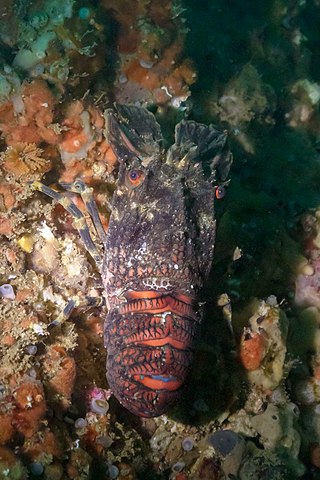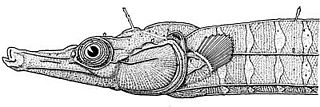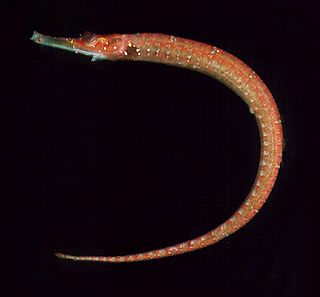
The gray smooth-hound is a houndshark of the family Triakidae. It is found on the continental shelves of the subtropical eastern Pacific, from northern California to the Gulf of California, between latitudes 40° N and 23° N, to a depth of 46 m. It can grow up to a length of 1.24 m.

The largenose catshark is a catshark of the family Scyliorhinidae. The largenose catshark is found on the upper continental slopes in the eastern Pacific, from the Gulf of Panama to Ecuador and central Chile, between 9°N and 28°S. It can grow up to 70 cm. Its reproduction is oviparous. This nose shark is considered to be a harmless species. It is known to originate from the Gulf of Panama, Ecuador, and Central Chile.
The false canyon mouse or Coronados deer mouse, is a species of rodent in the family Cricetidae. It is known only from Coronados Island, a small island in the Gulf of California, part of Baja California Sur, Mexico. The species is threatened by predation by feral cats, and the IUCN has assessed its conservation status as "critically endangered".

The striated bulbul is a species of songbird in the bulbul family, Pycnonotidae. It is the only species placed in the genus Alcurus .

The black jackrabbit is a species of mammal in the family Leporidae. Endemic to Mexico, its only known location is Espiritu Santo Island in the Gulf of California. The IUCN has listed this species as a "vulnerable species" because of its restricted range. This taxon is regarded by some authorities as being a subspecies of the black-tailed jackrabbit, found on the mainland of Mexico.

Scyllarus arctus is a species of slipper lobster which lives in the Mediterranean Sea and eastern Atlantic Ocean. It is uncommon in British and Irish waters, but a number of English-language vernacular names have been applied, including small European locust lobster, lesser slipper lobster and broad lobster.
Scyllarus pygmaeus is a species of slipper lobster that lives in shallow water in the Mediterranean Sea and eastern Atlantic Ocean. It grows to a length of 55 mm (2.2 in), which is too small for it to be fished for food. The juvenile form was first described in 1885, with the description of the adult following in 1888 as a result of the Challenger expedition.

Cosmocampus is a genus of pipefishes.

Cosmocampus albirostris is a marine fish of the family Syngnathidae. It is found in the western Atlantic Ocean, along the US coast from North Carolina to Florida, in the Gulf of Mexico, along the Yucatán Peninsula to Cuba, in the Caribbean from Puerto Rico to Grenada, and along Central and South America to southern Brazil. It lives among coral reefs, sea floor rubble, and sparse algae to depths of about 40 metres (130 ft), where it can grow to lengths of 20 centimetres (7.9 in). This species is ovoviviparous, with males carrying eggs in a brood pouch and giving birth to live young The Cosmocampus albirostris is a species of pipefish that has been historically collected in the State of Bahia. These species are in the Brazilian list of marine fishes that are authorized to be exported for ornamental purposes. This information was taken from a case study that monitored the ornamental trade of seahorses and pipefishes in Brazil, where harvesting of pipefish is common, and it was also discovered that Cosmocampus albirostris are predominantly harvested in reef areas.
Cosmocampus balli is a species of fish of the family Syngnathidae. It is endemic to Hawaii, with observations off Oahu and Kauai. It lives is shallow, protected coral reef or rocky habitats, where it can grow to lengths of 7 centimetres (2.8 in). Although little is known about its feeding habits, it is expected to consume small crustaceans, similar to other pipefishes. This species is ovoviviparous, with males carrying eggs and giving birth to live young. Males can brood at 4.5 centimetres (1.8 in).

Cosmocampus banneri is a species of marine fish of the family Syngnathidae. It is found from the Red Sea and Western Indian Ocean to Fiji, the Marshall Islands, and the Ryukyu Islands. It lives in coral reefs at depths of 2-30m, where it can grow to lengths of 5.8 cm. Although little is known about the feeding habits of C. banneri, it is expected to feed on small crustaceans similar to other pipefish. This species is ovoviviparous, with males carrying eggs in a brood pouch until giving birth to live young.
Cosmocampus brachycephalus is a species of marine fish of the family Syngnathidae. It is found in the western Atlantic Ocean, near southern Florida (USA), the Bahamas, and northern South America. It lives in sub-tidal grass flats to depths of 10 metres (33 ft), where it can grow to lengths of 10 centimetres (3.9 in). This species ovoviviparous, with males carrying eggs and giving birth to live young.
Cosmocampus darrosanus is a species of marine fish of the family Syngnathidae. It is found in the Western Indian Ocean, Sri Lanka, Indonesia, Guam, and the Great Barrier Reef (Australia). It lives in tidepools and coral reefs to depths of 3 metres (9.8 ft), where it can grow to lengths of 7.4 centimetres (2.9 in). This species is ovoviviparous, with males carrying eggs before giving birth to live young.
Cosmocampus elucens is a species of marine fish of the family Syngnathidae. It is found in the western Atlantic, off the U.S. east coast, Bermuda, the Bahamas, the Gulf of Mexico, throughout the Caribbean Sea, and off the coast of Brazil. It lives in seagrass and algae beds, typically at shallow depths, where it can grow to lengths of 15 centimetres (5.9 in). It is expected to feed on small crustaceans, similar to other pipefishes. This species is ovoviviparous, with males carrying eggs and giving birth to live young.
Cosmocampus heraldi is a species of marine fish of the family Syngnathidae. It is known from only seven specimens, which were found at the Desventuradas and Juan Fernandez Islands in Chile. It inhabits rocky reefs and sandy areas at depths of 6–23 metres (20–75 ft), where it can grow to lengths of 7 centimetres (2.8 in). It is expected to feed on small crustaceans like other pipefish. This species is ovoviviparous, with males carrying eggs until giving birth to live young.
Cosmocampus howensis is a species of marine fish of the family Syngnathidae. It is found in the South Pacific from Jervis Bay to Easter Island. It lives in lagoons and on rocky reefs, where it grows to lengths of 10–12 centimetres (3.9–4.7 in). It is expected to feed on small crustaceans, similar to other pipefishes. This species is ovoviviparous, with males carrying eggs before giving birth to live young.
Cosmocampus investigatoris is a species of marine fish of the family Syngnathidae. It is found in the Indo-West Pacific, from the Persian Gulf to the Gulf of Thailand. It lives over sand, mud, and coral bottoms to depths of 15m, where it can grow to lengths of 9 cm. This species is ovoviviparous, with males carrying eggs in a brood pouch until giving birth to live young.

Cosmocampus maxweberi is a species of marine fish of the family Syngnathidae. It is found in the Red Sea from Sumatra to Tonga and Samoa, and from the Marshall Islands to the Great Barrier Reef. Adults live in reefs and reef-rubble to depths of 36 m, while planktonic juveniles have been found in the top 85m of 1500–2000 m water columns. Adults are expected to feed on small crustaceans, similar to other pipefish, and can grow to lengths of 10 cm. This species is ovoviviparous, with males carrying eggs until giving birth to live young.
Cosmocampus retropinnis is a species of marine fish of the family Syngnathidae. The name retropinnis comes from the location of the species' dorsal fin as either caudal or posterior. The coloration of this organism is mostly brown and tan markings on its snout side, head's dorsum, side of the trunk, and venter of the tail. It is only known from a few juvenile specimens collected off southern Morocco and Gambia at depths to 79m. Little is known about its feeding habits, but it is expected to feed on small crustaceans, similar to other pipefish. This species is ovoviviparous, with males carrying eggs before giving birth to live young.
Cosmocampus coccineus is a species of pipefish from the family Syngnathidae. It is found in the eastern Pacific Ocean from Bahía de Banderas in Mexico south to Bahía de la Independencia, southern Peru, and in waters off the Galapagos Islands. It is common among red algae and coral, down to depths of 18 metres (59 ft). It is an ovoviviparous breeder in which the male carries the eggs in a brood pouch which is located under his tail. C. coccineus has been regarded as a subspecies of C. arctus, along with C. heraldi.








